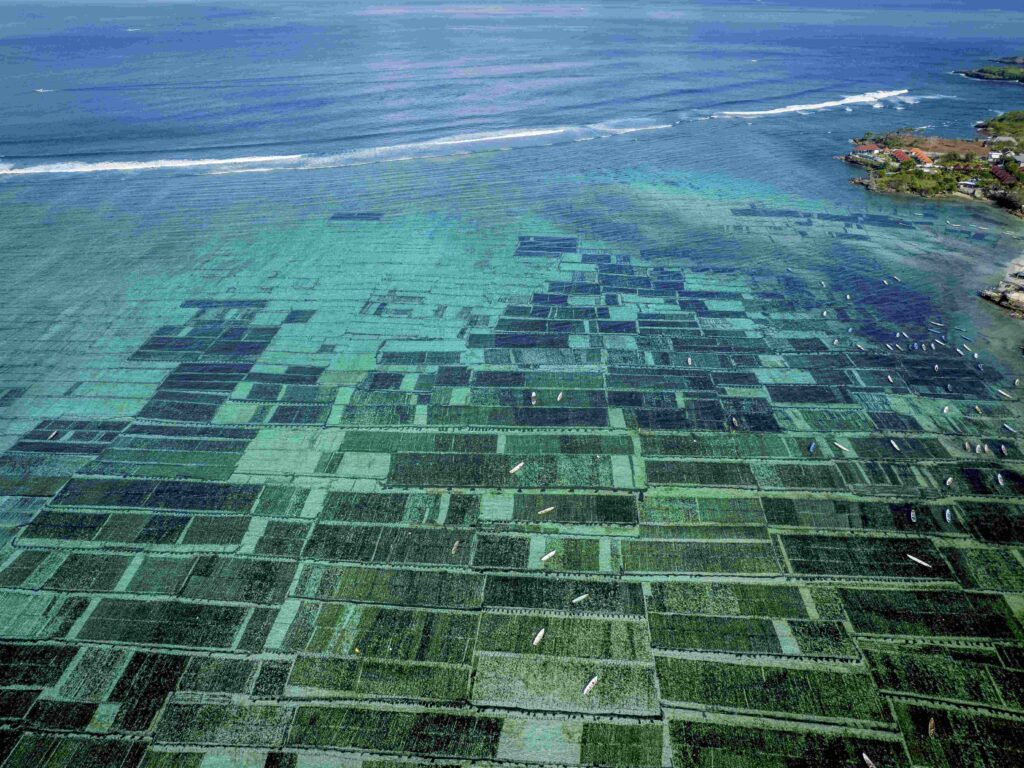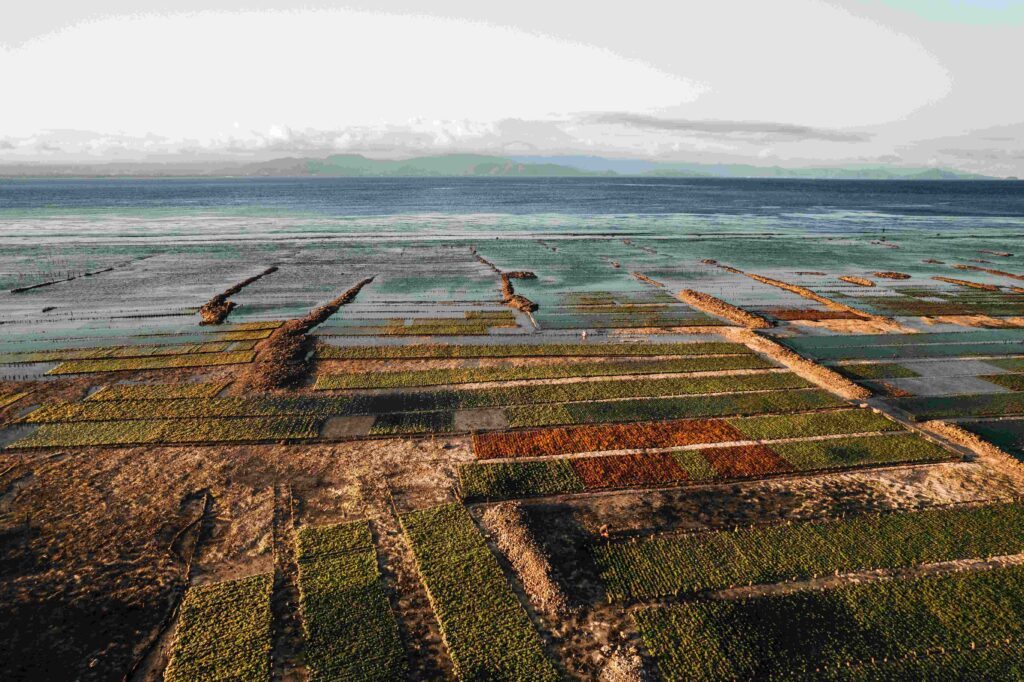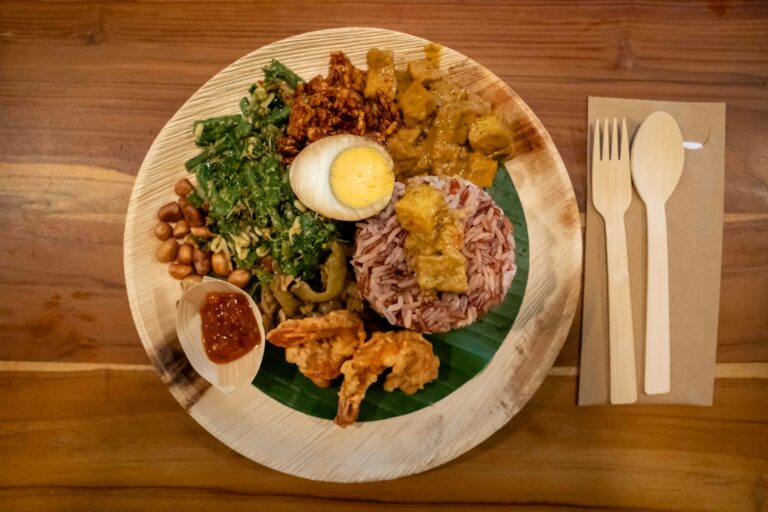Running a seaweed farm in Bali used to be a serious profession and the seaweed farmer who excelled at seaweed cultivation could be assured of a job for life and profits too.
But by 2017, the income from tourist destinations around Bali was so much greater than that of the seaweed farming industry that seaweed farming was pretty much dead on the island.
Then the pandemic hit and seaweed seeds were a route back into seaweed farming and seaweed farmers found that they could earn a living growing seaweed outside of the tourism sector.
Now, in 2024 (as we go to press), the tourists are back in full force. Does this mean that planting seaweed will die out once more and will the island’s seaweed plots be abandoned once again?
We don’t think so and, in fact, Nusa Lembongan’s seaweed farms are all already becoming an established part of the tourism trade and they make a fascinating spectacle on a Bali holiday.
Here’s what you need to know about the seaweed farms of Bali and the future of this traditional industry.
The Economics Of Seaweed Farming In 2024 And Beyond

Farming seaweed here in Bali was a relatively new thing and it seems to have started around 1982, before which while there was seaweed farming in the rest of Indonesia, there wasn’t on the island.
Then seaweed seeds were brought to Nusa Lembongan and the area began to farm. However, this farming didn’t make for an easy life and the seaweed farmers of the time said that their crops often failed, they didn’t earn enough on the open market, that plastic waste and other development-related issues encroached on their drying spaces and tourism jobs offered more security (though not always a better level of income).
Today, in a post-pandemic world, there appears to be a realization in Nusa Lembongan and across Bali’s economy that reliance on tourism alone, is not always a smart bet.
Tourism Dependence Is A Bad Idea
While 85% of Bali’s economy is essentially tourism-dependent, nearly 65% of the businesses are foreign-owned and while Southern Bali may flourish in normal conditions, in the event of a pandemic or severe volcanic eruption or even a tsunami brought in on the high and low tide of the Indian Ocean, tourism can collapse for long periods of time.
Many Balinese people lost their jobs during the pandemic and this forced the people of Nusa Lembongan, Nusa Penida, Nusa Ceningan and other Balinese provinces to re-examine their attitude to seaweed farming.
It’s also fair to say that seaweed farming can play a part in tourism itself, many tourists visit Nusa Lembongan, at least in part, to see the process of local people bringing in their next harvest.
This makes farming more profitable than it once was and gives the farmer additional income in the good times, and it’s income that they can manage without in the unlikely event of another tourism economy shutdown.
Other Seaweed Farming Sites In Bali

There are also farms in Klungkung which is the smallest Balinese regency that reopened during the pandemic.
This is a challenging area as there are complex ancestral claims to different farming areas and thus, the farms are small and family-owned.
This often prevents economies of scale and it’s an issue that’s understood by and being addressed by the local community, though the question is with so many locals will it ever be resolved?
Until then, farmers are reluctant to carry on this kind of work as their earnings don’t justify taking part in the seaweed supply chain.
Climate Change Fears
It’s fair to say that for the average Balinese seaweed farmer that it’s not so much the climate that worries them, as the endless amount of plastic waste that seems to be dumped into the waters that flow nearby Bali.
Local residents, corporations and the government are tackling this problem but this small island cannot carry the responsibility for plastic trash dumped all over the archipelago and in the Philippines, Malaysia and Singapore.
The shallow waters where harvesting takes place are particularly vulnerable to this kind of pollution.
The Future Of Bali’s Seaweed Trade

The truth is that this industry is in a fragile state. It will probably continue in Nusa Lembongan where there are few restrictions on this activity and it can take advantage of tourism to boost revenues for the farms.
However, in the rest of Bali, government intervention is probably required to resolve the current problems to make this activity profitable and appealing to farmers. Without such action, it’s likely that the farms will disappear once more.
FAQs
Is Seaweed Farming Profitable In Bali?
Yes, though you might not choose to plant seaweed seedlings on a seaweed farm for a living as it tends to offer the seaweed farmers a subsistence living rather than a life of luxury.
The average price of a kilo of the dried seaweed is about $0.80 USD (that’s around $1.20 AUD) and seaweed cultivation brings in about $400 USD or $600 AUD a month as an average income for the farmer.
Now, given that the average wage here in Bali is around 2.5 million IDR (that’s about \$150 USD or \$225 AUD) and it’s less on the island of Nusa Lembongan, this isn’t a terrible wage but it’s not the kind of money that makes someone rich.
It’s this relatively low return from running a seaweed farm that leaves this sector vulnerable to the workers leaving for the tourism industry.
After all, would you want to spend your life wading into the sea at low tide to gather seaweed if you could earn more behind a bar on the mainland?
Which Country Is The Largest Produce Of Seaweed? Where Is The Most Seaweed Farmed?
China is the largest producer of seaweed and they grow seaweed for more than half of the world’s seaweed consumers.
What Is Nusa Lembongan Seaweed Used For?
Once the seaweed has been through the harvesting process it must be cured. Then, the dried seaweed is bundled up and sold.
It has uses in cooking for nori rolls, and as an ingredient for sugar syrup, but can also be used to make soap and even constitutes some of the ingredients in cosmetic products.
What Are The Top 3 Regions For Seaweed Production?
China is the biggest producer of seaweed, then Indonesia which produces a quarter of the world’s seaweed, and then South Korea which produces just 6% of the total market demand.
Are There Seaweed Farmers In Bali?
Yes, the majority of seaweed farmers in Bali are on Nusa Lembongan, which is an island off the coast of the mainland and part of a collection of three islands known locally as the Nusa Islands (Nusa Lembongan, Nusa Penida and Nusa Ceningan).
How To Book A Holiday To See Seaweed Farming In Bali
If you want to see a seaweed farm on the island of Nusa Lembongan or any other part of Bali, we’d strongly recommend that you book your holiday through the Bali Res Centre.
This is a local travel service that can offer the best deals on flights, hotels, and tours and ensure you get to see all the tourist destinations that you want with the minimum of fuss.
Final Thoughts On Seaweed Farms In Bali
Running a seaweed farm may not be ideal for local farmers, who often wish that they could find more lucrative work for more money on the mainland, but it seems that in Nusa Lembongan, at least, seaweed farming is here to stay.
Given that the farmers on the island of Nusa Lembongan can cash in on their crops twice, firstly when they sell them and secondly, by charging tourists a small fee to see them sell seedlings, the harvesting process, etc. this form of farming can be more profitable than ever before.
We’d recommend that you book a holiday to take in Nusa Lembongan’s seaweed farming communities soon though, just in case the industry dies off again.













